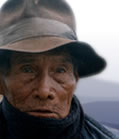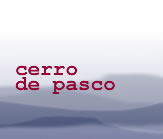THEMES IN THIS
TESTIMONY
Culture and Customs

Economics

Education

Gender

Health

History

Land

Traditional Skills

Click on arrows
to find more
testimonies
featuring
these themes
|
|
Sex
|
female
|
|
|
Age
|
70
|
|
|
Occupation
|
campesina
|
|
|
Location
|
Quiulacocha
|
|
|
Date
|
1995
|
|
summary
This elderly lady remembers back to the days of the great haciendas (estate farms) before the Agrarian Reform. Abandoned by her father at birth, she was brought up by her mother on the Andachaca estate. She talks fondly of how she would help her mother and contribute to the family economy from a young age; forced out of school by poverty, she grew up knitting and weaving, making and selling butter in the markets nearby. She was married abruptly at 14 years old - she tells of how she was “robbed” by her husband-to-be and then forced into marriage by her family. It is unclear whether she was actually raped or whether he made her “his” by some other violently possessive act.
She vividly describes her own wedding celebrations and some of the village wedding customs which remain until this day. As for married life, her’s has been hard. Her husband has always been a sick man (rheumatism) and has found it hard to get work. Apart from the few animals he used to rear, he’s worked in the foundry and as a nightwatchman for the mines and the cooperative. Dominica has always worked to provide for home and family - selling her knitting, sewing sacks for carrying minerals, buying and selling livestock.
With a mixture of fact and folklore, she provides a vivid picture of village life. She describes the Carnival celebrations - the typical foods, dances and traditions, dressing up the llamas and sheep. She describes the mythology of the lake - the bulls attacked her husband one night because he was drunk and he’s been sick ever since, as a punishment. She talks about traditional healing methods and how her husband has been treated for his illness in this way. She remembers the wildlife, frogs, fish and birds, which exist no more.
Of her 14 children, eight are still alive, but none of them live in Quiulacocha any more. They have tried to get her to move away from the village but she has no interest in living elsewhere. She’d never get used to life in Lima - because “there’s nothing there but sand”. She remembers the Quechua language which she learnt as a child. She teases the interviewer by not translating what she says - so that he too can learn the language of his ancestors.
detailed breakdown
|
You will need a password from Panos to view the full
transcript of the interview. To apply for a password, click here.
Once you have a password, click here to go to the beginning
of the transcript. You can also click on any section of the
breakdown of content below and go straight to the
corresponding part of the transcript.
|
| Section 1 |
Her childhood and description of life on the hacienda, before the Agrarian Reform.
|
| Section 2 |
Poverty takes her away from school and forces her to earn money for the family purse – knitting, barter etc which she continues to this day because her husband is a sick man
|
| Section 3 |
Description of her marriage as a child bride. Wedding celebrations – serve a roast and then tosta (toasted maize).
|
| Section 4 |
Describes how they prepare the roast and guinea-pig. Pride in the traditions of Quiulacocha. Tells of the work she and her husband have done in their time.
|
| Section 5 |
Tales from the lake – whales which made people disappear, people gathering frogs to eat. Eight children all married - she cannot remember all their names. Some of her children are in the mines.
|
| Section 6 |
She thinks mining is a good job for them because it is local, stops them moving out as most have done. Description of the Baile Viejo (“old dance”) and the Chonguino – typical dances of the region. Description of Carnival time – responsibility of the steward to pay for everything and organise it all.
|
| Section 7 |
Gives recipes for traditional foods – patasca (traditional soup), potatoes a la huancaina (with melted cheese and garlic), pachamanca (meat and vegetables cooked in underground ovens). More details of the dance and dressing up animals - llamas and sheep with ribbons.
|
| Section 8 |
Chica is the traditional drink made from corn.
Her views on married life – men chose partners who’ll cook and sew for them not just please them in bed. Things have changed a bit for the new generations but not much. People are marrying outsiders more - they travel more and pick up other customs.
|
| Section 9 |
Her husband is 87 and suffers from ill health due to his age. He comes from a wealthy farming family but his father drank away the family wealth once his mother died. She remembers how much more prosperous Quiulacocha used to be - and the seagulls of Quiulacocha which gave the village its name, also the myth of the bulls from the lake who got angry because foreigners were trying to take away the gold and how her husband was attacked by the bull one night when he was drunk.
|
| Section 10 |
More about her husband being attacked by the bulls of the lake. Since this time they’ve had to do judeo - traditional cures they have used to try to make her husband well. Describes other traditional treatments.
|
| Section 11 |
Conventional medicine has its place too and so does the coca leaf. Her mother taught her to read coca leaves and she sees the future as Centromin kicking them out. She used to rear livestock, but not now - the grass is no good and the water polluted. Her desire for the rehabilitation of the lake. Her children come home to Quiulacocha when she needs them - if for example, she is ill.
|
| Section 12 |
She has no desire to leave the village, nor does her husband but her children are always trying to get them to move away. She says a few things in Quechua – young people don’t learn it anymore.
|
| Section 13 |
She teases the interviewer by speaking in Quecha and tells him to work out what she said so he too can learn. |
|


